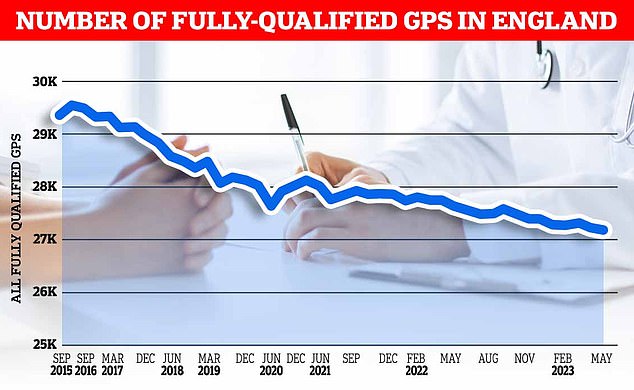Patients should be able to see SAME GP every time, safety watchdog says after death of cancer-stricken man
Patients should be able to see the same GP every time to reduce potentially fatal delays in diagnosing serious conditions, the safety researcher said.
The Health Service Safety Investigations Body also wants computer systems updated so they alert doctors if someone returns with the same problem.
It comes after a man who recovered from breast cancer repeatedly visited his GP with back pain and also went to A&E, where his family said he was accused of wasting time.
He was eventually diagnosed with secondary breast cancer that had spread to his back, with a tumor pressing on his spinal cord.
Chart shows the ratio of GP patients to practices since 2015, with an average of 9,755 patients per surgery in May 2023
The patient, Brian, 67, visited at least two out-of-hours GPs, six practice GPs, a nurse and a physiotherapist in the GP practice and attended A&E over a period of eight months.
He later died of his cancer.
A study found a range of problems, including that GPs’ workload was impacting on patient care, that there was no national system for continuity of care, and that patient records were often presented chronologically, meaning that a pattern of repeat visits for the same thing can be missed if mixed with appointments for other conditions.
The HSSIB defined continuity of care as a relationship with a specific physician, but also as how information was managed in a practice so that each physician could care for the patient.
The HSSIB concluded: ‘HSSIB recommends that the Department of Health and Social Care ensures that the GP contract explicitly includes and supports the need for GP practices to provide continuity of care.
‘This is to improve patient safety by building doctor-patient relationships and providing continuity of information.’
In its report, the HSSIB states that there is no specific requirement for GPs to ensure that the practice provides continuity of care for their patients.

GP workforce data for May 2023 shows there are 27,200 fully qualified GPs in England. This is a decrease compared to the 27,627 a year earlier. The GP number peaked in March 2016 at 29,537
They could do this voluntarily, but there was no standard framework to achieve this, resulting in variation across England.
“Some practices have implemented systems effectively, but many have not, and HSSIB research has shown the impact of the lack of a formal system on patient safety, on GP wellbeing and on practice operational efficiency,” said the report.
Researchers reported that all GPs they spoke to were aware of the benefits of continuity of care, but some did not believe this could be achieved in their practice.
Barriers included the complex social conditions of the geographical area and the availability of personnel.
The research also found that there was no requirement for GPs’ IT systems to consider continuity of care or to ‘surface’ information to GPs so they could see people returning with the same problem. It has made recommendations to NHS England on this issue.
Neil Alexander, senior safety researcher, said: ‘What struck our team during the research was the clear differences in patient experience and GP wellbeing between practices that adopt a continuity of care model and those that do not.
‘We could see that they all want to deliver the best possible care, but the extreme pressure of the workload and having to prioritize other essential requirements makes it very difficult.
‘While practices with systems could see benefits, they told us they were often implemented without the right frameworks, guidance and explicit funding.
‘It became clear to us that if GP practices are to consistently prioritize continuity of care, this must become part of the essential services they are required to provide.
‘Brian’s case was a stark example of what can happen when there is a break in that continuity – it was incredibly painful for him and his family.
“He told our team, ‘If I’m gone, no one else should have to go through what I did.’
‘The emotional impact also emerged in interviews with his practice, with one GP describing the current system as ‘brutal’.’

The HSSIB defined continuity of care as a relationship with a specific physician (stock image)
Dr. Victoria Tzortziou-Brown, vice-president of the Royal College of GPs, said continuity of care is ‘highly valued by both GPs and patients… but delivering continuity of care is becoming increasingly difficult as GPs and our teams struggle with the intense pressure on staff and need to grow, both in volume and complexity.’
She said a recent survey by the RCGP found that 54 per cent of GPs are unable to provide consistent continuity of care in the way they want and meet the needs of their patients.
She added: ‘It is not easy to make continuity of care a ‘requirement’ as it can mean different things to different practices and patients, and some patients may value and benefit from it more than others.
‘Ultimately, given the current pressures, it is difficult to see how such a requirement would be feasible for many practices.’
An NHS England spokesperson said GPs are making record numbers of appointments and the health service is making it easier for patients to book consultations.
A spokesperson for the Department of Health and Social Care also said: ‘Continuity of care is important and all patients should be provided with a named GP.
‘Practices must try to meet all reasonable requests from patients to see a particular GP or other healthcare professional, and people have the legal right to choose which practice they register with.
‘We’re making it easier for patients to see their GP by cutting red tape so practice teams can free up more time for their patients, and we’ve committed £240 million in additional funding to improve technology in GP practices so patients can connect with can include them. .
‘There are now an average of 29 more appointments in each general practice, per working day, more than 2,600 extra doctors and 34,000 extra employees, compared to 2019.’
